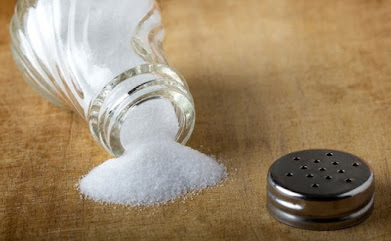Salt: How much is too much?
Salt: How much is too much?
The Dietary Guidelines for Americans suggest that grown-ups consume under 2,300 milligrams of sodium each dayTrusted Source - the identical to around 1 teaspoon of salt - as a feature of a solid eating routine.
A report from the Centers for Disease Control and Prevention (CDC) delivered recently, notwithstanding, tracked down that around 90% of grown-ups and youngsters in the U.S. consume more than the suggested sodium admission, with most grown-ups consuming in excess of 3,400 milligrams day to day.
CDC Director Dr. Tom Frieden marked the report discoveries "alarming,"Trusted Source noticing that all the more should be finished to lessen the salt admission of Americans and "save lives."
Furthermore, it appears to be the U.S. Food and Drug Administration (FDA) concur; recently, the association gave draft guidelinesTrusted Source for the decrease of sodium in handled food varieties, which represent around 75% of all salt utilization.
The point of these rules is to bring down salt admission among purchasers to the suggested degree of 2,300 milligrams everyday, to decrease the wellbeing chances related with high salt utilization.
Nonetheless, a few specialists propose that such a level is excessively low. As a matter of fact, some say that consuming salt in such limited quantities might try and cause more damage than great.
Salt admission: The advantages and dangers
As per the American Heart Association (AHA), around 90% of Americans' sodium admission comes from sodium chlorideTrusted Source, viewed as in table salt and frequently added to handled food varieties for protection and flavor.
How much sodium is in your food?
A solitary cut of bread contains somewhere in the range of 80-230 milligrams of sodium
Some morning meal grains can contain up to 300 milligrams of sodium before milk is added
One cut of frozen pizza can contain 370-730 milligrams of sodium.
Find out about salt
It is notable that the body needs some salt; it is significant for nerve and muscle capability, and it controls organic liquids.
One review, distributed in the diary Cell Metabolism last year, even proposed that salt utilization can fight off destructive bacteriaTrusted Source and decrease the gamble of contamination.
Nonetheless, various investigations have demonstrated that consuming a lot of salt can expand the gamble of serious medical conditions, especially with regards to cardiovascular wellbeing, with research connecting high salt admission to hypertension, stroke, and coronary illness.
A review distributed in the Journal of Agricultural and Food Chemistry recently likewise recommended a high-salt eating regimen might cause liver harm, while another review connected high salt admission to expanded hazard of different sclerosis (MS).
The reason for which high salt admission can inflict damage is a possible one; a lot of salt can make the body hold water, which can overburden the heart and veins, raising circulatory strain and expanding the gamble of cardiovascular illnesses.
Be that as it may, when does salt admission quit aiding and beginning impeding our wellbeing? This stays a subject of discussion.
Are current salt admission proposals excessively low?
While current rules suggest consuming less 2,300 milligrams of sodium everyday, a review detailed by Medical News Today last month recommended that even 3,000 milligrams of sodium day to day might be close to nothing and could jeopardize wellbeing.
Driven by scientists from McMaster University in Canada, the investigation discovered that grown-ups who consumed under 3,000 milligrams of salt a day were at more serious gamble of coronary failure, stroke, and unexpected passing than those with a typical sodium consumption.
Furthermore, the group scrutinized the wellbeing dangers of high salt admission, observing that it was just grown-ups who previously had hypertension who were at more serious gamble of coronary illness and stroke with high salt admission - characterized as 6,000 milligrams everyday.
"While our information features the significance of decreasing high salt admission in individuals with hypertension, it doesn't uphold diminishing salt admission to low levels," finished up concentrate on pioneer Andrew Mente, of McMaster's Michael G. DeGroote School of Medicine.
This isn't the primary review to scrutinize the ongoing salt admission rules; a recent report directed by Michael H. Magistrate, of the Albert Einstein College of Medicine in New York City, found that decreasing salt admission to under 2,500 milligrams daily was not connected to diminished hazard of the ailments related with high salt utilization.
'The science is clear - diminishing salt brings down pulse'
Regardless of such discoveries, the FDA close there is an "staggering collection of logical proof" that diminishing everyday sodium admission to under 2,300 milligrams can forestall the wellbeing dangers of a high-salt eating routine.
"Specialists at the Institute of Medicine have reasoned that lessening sodium admission to 2,300 milligrams each day can altogether assist Americans with diminishing their pulse and at last forestall countless untimely sicknesses and passings," notes Susan Mayne, Ph.D., head of the FDA's Center for Food Safety and Applied Nutrition.
Also, the association focuses to past examinations that have proposed bringing down sodium admission in the U.S. by around 40% over the course of the following 10 years can save around 500,000 lives and diminish medical services costs by around $100 billion.
The CDC reverberation the FDA's view on lessening salt admission. "The science is clear - diminishing salt brings down circulatory strain," says Dr. Frieden, "and hypertension is a significant gamble factor for cardiovascular sickness."
Addressing The New York Times recently, Dr. Frieden recognized that there are various specialists who differ that decreasing salt admission further develops wellbeing results, yet he guarantees the investigations they refer to have "tragic defects."
Making sense of what defects Dr. Frieden is alluding to, nutritionist Cheryl Anderson, individual from the 2015 Dietary Guidelines Advisory Committee, told The Washington Post that a considerable lot of the examinations refering to the adverse consequences of low-salt eating regimens have just utilized few pee tests to arrive at their decisions, meaning the discoveries could delude.
Moreover, Anderson expressed a portion of these examinations may be dependent upon "invert causality," where rather than low-salt eating regimens causing cardiovascular illnesses, it may be the case that such infections make individuals consume low-salt weight control plans.
Further examination concerning salt utilization is required
While it appears to be numerous wellbeing specialists are on the side of government techniques to lessen salt admission among the overall population, others say more examination ought to be directed on the drawn out wellbeing impacts of low-salt weight control plans prior to making suggestions.
Moreover, numerous specialists and associations - including the Grocery Manufacturers Association (GMA) - accept further examination is expected to pinpoint the specific salt admission that is generally useful for wellbeing.
"Like others inside and beyond government, we accept extra work is expected to decide the adequate scope of sodium admission for ideal wellbeing," says Leon Bruner, boss science official of the GMA.
"This assessment ought to incorporate examination that shows wellbeing gambles for individuals who consume a lot of sodium as well as wellbeing takes a chance from consuming too little sodium."
In view of the ongoing proof, it appears to be observing the ongoing dietary rules for salt admission is the most effective way to decrease the wellbeing chances related with high salt utilization.

.jpeg)


Comments
Post a Comment